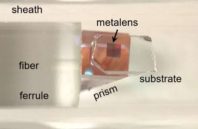The diagnosis of diseases based in internal organs often relies on biopsy samples collected from affected regions. But collecting such samples is highly error-prone due to the inability of current endoscopic imaging techniques to accurately visualize sites of disease. The conventional optical elements in catheters used to access hard-to-reach areas of the body, such as the gastrointestinal tract and pulmonary airways, are prone to aberrations that obstruct the full capabilities of optical imaging.
Now, experts in endoscopic imaging at Massachusetts General Hospital (MGH) and pioneers of flat metalens technology at the Harvard John A. Paulson School of Engineering and Applied Sciences (SEAS), have teamed up to develop a new class of endoscopic imaging catheters—termed nano-optic endoscopes—that overcome the limitations of current systems.

 (585) 768-2513
(585) 768-2513

